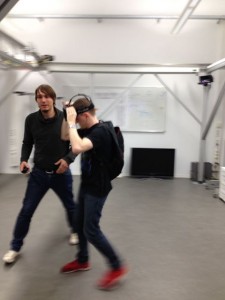 The German town of Karlsruhe is no stranger to advanced technology, as home to the Karlsruhe Institute of Technology (KIT) and the ZKM Center for Art and Technology Karlsruhe. In his keynote for the November 2014 Digital Archiving conference at the ZAK Center for Digital Tradition (CODIGT), Still Water Co-Director Jon Ippolito presented advanced technologies as both the means for and object of novel preservation techniques. Emerging in Europe and the Americas, these new strategies harness everything from emulation to crowdsourcing to virtual reality.
The German town of Karlsruhe is no stranger to advanced technology, as home to the Karlsruhe Institute of Technology (KIT) and the ZKM Center for Art and Technology Karlsruhe. In his keynote for the November 2014 Digital Archiving conference at the ZAK Center for Digital Tradition (CODIGT), Still Water Co-Director Jon Ippolito presented advanced technologies as both the means for and object of novel preservation techniques. Emerging in Europe and the Americas, these new strategies harness everything from emulation to crowdsourcing to virtual reality.
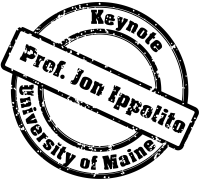 Ippolito asked how amateurs with special interest and skill might help professionals accomplish the hard work of documenting and conserving new media despite the ever-increasing pace of technological obsolescence. Entitled “Wagging the Long Tail of Digital Preservation,” the keynote drew on themes from his recent book co-authored with Richard Rinehart, Re-collection: Art, New Media, and Social Memory.
Ippolito asked how amateurs with special interest and skill might help professionals accomplish the hard work of documenting and conserving new media despite the ever-increasing pace of technological obsolescence. Entitled “Wagging the Long Tail of Digital Preservation,” the keynote drew on themes from his recent book co-authored with Richard Rinehart, Re-collection: Art, New Media, and Social Memory.
[The keynote, in English, follows a few words in German.]
One recurring theme was the scanning and representing of physical objects in three-dimensional virtual space. Re-collection surveys several models for crowdsourcing such 3d scans, but in his CODIGT talk Ippolito cited two examples local to Karlsruhe. One was the 3d models being created of media installations by Morgane Stricot, a media conservator at ZKM who was formerly a Variable Media Fellow at the University of Maine’s graduate Digital Curation program.
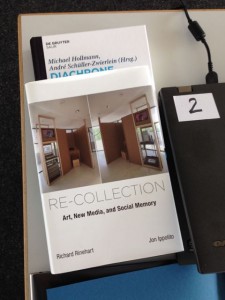 Virtual environments by Jesús Muñoz Morcillo, Florian Faion, and Antonio Zea represented a second, more futuristic approach to 3d capture. This team scanned a video sculpture by renowned artist Nam June Paik that incorporates endangered components like CRT monitors and neon tubes, and then re-created it in VR; the result is a 3d rendering that enables the wearer of an Oculus Rift headset to walk around the piece while the video runs in real time. Such “e-Installations” may someday provide a reference point for conservators that is more robust (if somewhat less accessible) than installation photographs or video footage. Standards for scanning and preserving 3d models were also the subject of talks by architectural archivists Martin Kunz and Mieke Pfarr-Harfst.
Virtual environments by Jesús Muñoz Morcillo, Florian Faion, and Antonio Zea represented a second, more futuristic approach to 3d capture. This team scanned a video sculpture by renowned artist Nam June Paik that incorporates endangered components like CRT monitors and neon tubes, and then re-created it in VR; the result is a 3d rendering that enables the wearer of an Oculus Rift headset to walk around the piece while the video runs in real time. Such “e-Installations” may someday provide a reference point for conservators that is more robust (if somewhat less accessible) than installation photographs or video footage. Standards for scanning and preserving 3d models were also the subject of talks by architectural archivists Martin Kunz and Mieke Pfarr-Harfst.
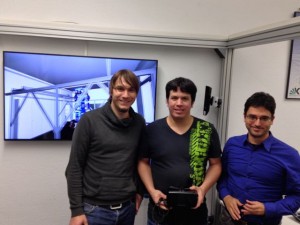 A topic that provoked some debate among presenters was whether emulation is a practical long-term preservation strategy. Jensâ€Martin Loebel of the University of Siegen acknowledged that emulators can be subject to a “translation gap,” such that artifacts in the original don’t survive emulation while errors can be multiplied when emulators are nested. Loebel also worried how to keep emulators fast enough, since the host computer must be faster than the original, and Moore’s law–whereby the speed of microprocessors doubles every 18 months–may be running out of gas.
A topic that provoked some debate among presenters was whether emulation is a practical long-term preservation strategy. Jensâ€Martin Loebel of the University of Siegen acknowledged that emulators can be subject to a “translation gap,” such that artifacts in the original don’t survive emulation while errors can be multiplied when emulators are nested. Loebel also worried how to keep emulators fast enough, since the host computer must be faster than the original, and Moore’s law–whereby the speed of microprocessors doubles every 18 months–may be running out of gas.
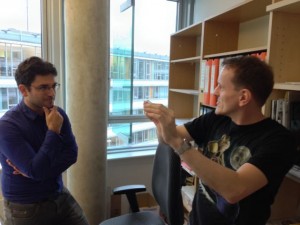 Nevertheless Ippolito and Loebel agreed that emulaters represented one of the few systematic successes in the field of digital preservation, a point that Dragan Espenschied, Rhizome’s new digital conservator, hammered home with live demos of ancient Hypercard stacks running in a contemporary browser. Suggesting that we must update the 19th-century definition of an archive as “things that are no longer used or in circulation,” Espenschied argued for an alternative that makes it easy for users to experience the behavior of the original object in a setting as close to the original as possible.
Nevertheless Ippolito and Loebel agreed that emulaters represented one of the few systematic successes in the field of digital preservation, a point that Dragan Espenschied, Rhizome’s new digital conservator, hammered home with live demos of ancient Hypercard stacks running in a contemporary browser. Suggesting that we must update the 19th-century definition of an archive as “things that are no longer used or in circulation,” Espenschied argued for an alternative that makes it easy for users to experience the behavior of the original object in a setting as close to the original as possible.
All three presenters concurred that the lion’s share of preservation software has come from amateurs working outside of institutions. Loebel described his study of successful emulators cited in journals: of the 40 surveyed, only one was created by a researcher; 90% came from hobbyists. Likewise, when the BBC destroyed Dr Who episodes for space reasons, fans recovered them all via home audio recordings. Fans have even inspired emulated hardware, such as joysticks you can buy to play vintage handheld games on an iPad.
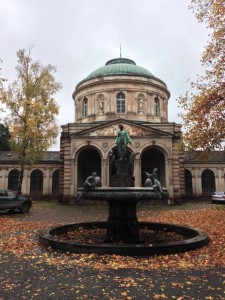 KIT’s Klaus Nippert suggested the dilemma faced by many archivists when he asked, “we keep electronic records of parking tickets. If we can, must we save these for the future too? Loebel argued that the people currently deciding what to preserve are the emulator-makers, who are mostly gamers. In her talk on the Deutsche Digitale Bibliothek (German Digital Library), Ellen Euler responded that “anything that’s not on the Internet is not in the world”–suggesting we should do our best to save as much as possible.
KIT’s Klaus Nippert suggested the dilemma faced by many archivists when he asked, “we keep electronic records of parking tickets. If we can, must we save these for the future too? Loebel argued that the people currently deciding what to preserve are the emulator-makers, who are mostly gamers. In her talk on the Deutsche Digitale Bibliothek (German Digital Library), Ellen Euler responded that “anything that’s not on the Internet is not in the world”–suggesting we should do our best to save as much as possible.
The conference was organized by Ralf Schneider and Caroline Robertson-von Trotha of ZAK (Zentrum für Angewandte Kulturwissenschaft und Studium Generale).

Marit Paasche liked this on Facebook.
Anna C Allahar liked this on Facebook.
Doug Sery liked this on Facebook.
Mark Daggett liked this on Facebook.
Richard Rinehart liked this on Facebook.
Oren Darling liked this on Facebook.
RT @rick_rinehart: Wagging the Long Tail of Preservation (@jonippolito with acknowledgements to Chris Anderson) http://t.co/AaxEbgmRyU
RT @stillwaternet: #Emulation, #crowdsourcing, and #VirtualReality: wagging the long tail of #DigitalPreservation http://t.co/OJcZS9sWrR
New #DigitalPreservation strategies from EU and US at conference organized by @codigt_zak @interretiatus @noosphaere http://t.co/5oiYBfw2KI
RT @jonippolito: RT @stillwaternet: #Emulation, #crowdsourcing, and #VirtualReality: wagging the long tail of #DigitalPreservation http://t…
Lisa Athy Moorhead liked this on Facebook.
RT @stillwaternet: #Emulation, #crowdsourcing, and #VirtualReality: wagging the long tail of #DigitalPreservation http://t.co/UxY6M1Ac1j
RT @jonippolito: New #DigitalPreservation strategies from EU and US at conference organized by @codigt_zak @interretiatus @noosphaere http:…
RT @DigitCurator #Emulation, #crowdsourcing, and #VirtualReality: wagging the long tail of #DigitalPreservation http://t.co/VT3vlmizML